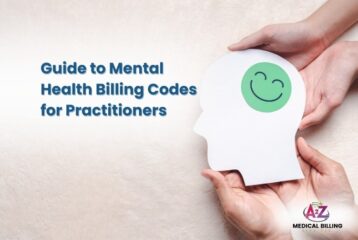Rehab ICD-10 codes are required for effective documentation and billing of rehabilitation facilities to healthcare insurances. These codes describe various statistics, ensuring that the right diagnosis has been identified and reported. By following efficient coding guidelines it helps avoid claim denials, assures timely claim filing and payment reimbursements. Understanding and utilizing these ICDs are essential for practitioners that want to keep billing procedures accurate and in accordance with healthcare compliance and regulations.
Comprehensive Cheat Sheet to ICD 10 Rehab Codes
Rehabilitation centers cover a wide range of diagnoses, providing comprehensive care to help individuals recover and regain functionality. The codes help standardize diagnoses, ensure accurate treatment, and facilitate effective communication among healthcare providers. Here are some common ICD codes used
Physical Rehabilitation ICD Codes
Physical Rehabilitation has various ICD-10 codes, including Orthopedic ICD-10 codes for musculoskeletal issues, Neurological ICD-10 codes for nervous system disorders, and Cardiopulmonary ICD-10 codes for heart and lung conditions.
| Orthopedic ICD-10 Code | Description |
| M16.0 | Primary osteoarthritis of hip |
| M17.0 | Primary osteoarthritis of knee |
| S72.001A | Fracture of unspecified part of neck of right femur, initial encounter for closed fracture |
| S42.001A | Fracture of unspecified part of right clavicle, initial encounter for closed fracture |
| S43.401A | Unspecified sprain of right shoulder joint, initial encounter |
| M75.100 | Unspecified rotator cuff tear or rupture of unspecified shoulder, not specified as traumatic |
| M75.51 | Bursitis of shoulder |
| M76.60 | Achilles tendinitis, unspecified leg |
| Neurological ICD-10 Code | Description |
| I69.351 | Hemiplegia and hemiparesis following cerebral infarction affecting right dominant side |
| S06.5X9A | Traumatic subdural hemorrhage with loss of consciousness of unspecified duration, initial encounter |
| G82.50 | Quadriplegia, unspecified |
| G35 | Multiple sclerosis |
| G20 | Parkinson’s disease |
| G12.21 | Amyotrophic lateral sclerosis |
| CardiopulmonaryICD-10 Code | Description |
| I21 | Heart attack (myocardial infarction) |
| S06.5X9A | Congestive heart failure (CHF) |
| J44 | Chronic obstructive pulmonary disease (COPD) |
| J84.10 | Pulmonary fibrosis |
| Z48.81 | Post-cardiac surgery recovery |
Cognitive and Speech ICD Codes
Cognitive and Speech ICD Codes include Cognitive Disorders ICD-10 codes for conditions affecting mental processes, and Speech and Language Disorders ICD-10 codes for issues related to communication abilities. These classifications help in accurately diagnosing and treating cognitive and speech impairments.
| Cognitive Disorders ICD-10 Codes | Condition |
| F07.81 | Post-concussion syndrome |
| F03 | Dementia and Alzheimer’s disease |
| I69.31, S06.2X9 | Cognitive impairments post-stroke or TBI |
| F90 | Attention deficit hyperactivity disorder (ADHD) |
| Speech and Language Disorders ICD-10 Codes | Condition |
| I69.32 | Aphasia (language impairment typically post-stroke) |
| R47.1 | Dysarthria (motor speech disorder) |
| R49.9 | Voice disorders |
| R13 | Swallowing disorders (dysphagia) |
Psychological And Behavioral Rehabilitation Conditions With ICD-10 Codes
Psychological and Behavioral Rehabilitation Conditions with ICD-10 codes include Mental Health Conditions ICD-10 codes for diagnosing psychiatric disorders, and Substance Abuse and Addiction ICD-10 codes for identifying dependency and abuse issues. These codes facilitate targeted therapeutic interventions and effective patient care.
| Mental Health Conditions ICD-10 Codes | Condition |
| F32-F33, F41 | Depression and anxiety disorders |
| F31 | Bipolar disorder |
| F43.1 | Post-traumatic stress disorder (PTSD) |
| F20-F29 | Schizophrenia and other psychotic disorders |
| Substance Abuse and Addiction ICD-10 Codes | Condition |
| F10.20 | Alcohol dependency |
| F11-F19 | Drug addiction (opioids, stimulants, etc.) |
| F63.0, F63.9 | Behavioral addictions (gambling, internet addiction) |
Pediatric Rehabilitation Conditions With ICD-10 Codes
Pediatric Rehabilitation Conditions with ICD-10 codes include Developmental Disorders ICD-10 codes for diagnosing delays and impairments in child development, and Congenital and Genetic Disorders ICD-10 codes for identifying conditions present from birth or inherited. These codes support precise diagnosis and specialized pediatric care.
| Developmental Disorders ICD-10 Codes | Condition |
| G80 | Cerebral palsy |
| F84.0 | Autism spectrum disorder (ASD) |
| R62 | Developmental delays |
| Q90 | Down syndrome |
| Congenital and Genetic Disorders ICD-10 Codes | Condition |
| G71.0 | Muscular dystrophy |
| Q05 | Spina bifida |
| E84.0 | Cystic fibrosis |
Geriatric Rehabilitation Conditions With ICD-10 Codes
Geriatric Rehabilitation Conditions with ICD-10 codes include Age-Related Conditions ICD-10 codes for diagnosing issues associated with aging, and Chronic Conditions ICD-10 codes for managing long-term illnesses. These codes aid in providing comprehensive care tailored to the elderly population.
| Age-Related Conditions ICD-10 Codes | Condition |
| R26.81, R26.89 | Mobility and balance issues |
| M81 | Osteoporosis |
| R41.81 | Cognitive decline |
| W19 | Post-fall recovery |
| Chronic Conditions ICD-10 Codes | Condition |
| M79.2 | Chronic pain management |
| E11 | Diabetes management and complications |
| N18.9 | Chronic kidney disease (CKD) |
Pain Management Conditions With ICD-10 Code
Pain Management Conditions with ICD-10 codes include Chronic Pain Conditions ICD-10 codes for diagnosing long-term pain issues, and Acute Pain Conditions ICD-10 codes for identifying short-term, severe pain. These codes assist in creating effective pain management plans for patients.
| Chronic Pain Conditions ICD-10 Codes | Condition |
| M79.7 | Fibromyalgia |
| M54.5, M54.2 | Chronic back and neck pain |
| G89.0 | Neuropathic pain |
| G90.5 | Complex regional pain syndrome (CRPS) |
| Acute Pain Conditions ICD-10 Codes | Condition |
| G89.18 | Post-surgical pain |
| S39.92XA, S89.9 | Injury-related pain |
Cardiac Rehab ICD 10 Codes and Condition
Cardiac Rehab ICD-10 codes cover a range of conditions related to heart health, including post-myocardial infarction, heart failure, and coronary artery disease. These codes are essential for developing comprehensive rehabilitation programs to improve cardiovascular health and recovery.
| Cardiac ICD-10 Codes | Condition |
| I21 | Heart attack (myocardial infarction) |
| I25.10 | Chronic ischemic heart disease |
| I50.9 | Heart failure |
| I20.9 | Angina pectoris |
| I71.4 | Aortic aneurysm |
Pulmonary Rehabilitation Conditions With ICD-10 Codes
Pulmonary Rehabilitation Conditions with ICD-10 codes include chronic obstructive pulmonary disease (COPD), asthma, and interstitial lung disease. These codes are used to diagnose and manage respiratory conditions, enabling tailored rehabilitation programs to enhance lung function and overall respiratory health.
| Pulmonary Rehabilitation ICD-10 Codes | Condition |
| J44.9 | Chronic obstructive pulmonary disease (COPD) |
| J43.9 | Emphysema |
| J84.10 | Pulmonary fibrosis |
| J45.909 | Asthma |
| J47.9 | Bronchiectasis |
Specialized Rehabilitation Conditions With ICD-10 Codes
Specialized Rehabilitation Conditions with ICD-10 codes include Burn Rehabilitation ICD-10 codes for diagnosing and treating burn injuries, and Amputee Rehabilitation ICD-10 codes for managing the recovery and adaptation process following limb loss. These codes ensure precise treatment plans and comprehensive care for specialized rehabilitation needs.
| Burn Rehabilitation ICD-10 Codes | Condition |
| T31.0-T 31.9 | Recovery from severe burns |
| Z48.812 | Skin graft care and management |
| T79.8 | Pain management and scar treatment |
| Amputee Rehabilitation ICD-10 Codes | Condition |
| Z89.6-Z89.9 | Post-amputation recovery |
| Z44.8 | Prosthetic training and use |
| G54.6 | Phantom limb pain management |
How to identify the accurate ICD 10 Rehab Codes for claim processing ?
Identifying the accurate rehabilitation code (ICD-10) requires a systematic approach to ensure that the chosen code precisely matches the patient’s diagnosis and treatment plan. Here are steps to help you accurately identify the correct rehabilitation code:
Steps to Identify Accurate Rehabilitation Code
- Patient Evaluation and Diagnosis
- Conduct a thorough evaluation of the patient, including medical history, physical examination, and relevant diagnostic tests.
- Establish a precise diagnosis based on clinical findings and diagnostic criteria.
- Consult Official ICD-10 Guidelines
- Refer to the latest ICD-10-CM (International Classification of Diseases, 10th Revision, Clinical Modification) guidelines.
- Use the official ICD-10-CM coding book or an online ICD-10 lookup tool.
- Identify the Main Diagnosis
- Determine the primary condition requiring rehabilitation (e.g., stroke, traumatic brain injury, spinal cord injury).
- Identify any secondary conditions or complications that may also need coding.
- Use Specific and Accurate Codes
- Choose the most specific code available for the condition. Avoid using unspecified codes whenever possible.
- Ensure the code reflects the precise nature and severity of the condition.
- Cross-reference with Clinical Documentation
- Ensure that the selected ICD-10 code aligns with the clinical documentation in the patient’s medical records.
- Verify that all relevant details are documented, including the type of rehabilitation required (e.g., physical, cognitive, speech).
- Consult Coding Resources
- Utilize coding manuals, online databases, and coding software to find the correct codes.
- Reference coding guidelines from organizations such as the American Health Information Management Association (AHIMA) and the Centers for Medicare & Medicaid Services (CMS).
- Check for Code Updates
- Regularly check for updates to the ICD-10 codes, as new codes may be introduced or existing codes may be revised.
- Use the most current version of the ICD-10-CM.
- Seek Expert Advice
- If in doubt, consult with a certified medical coder or a healthcare professional specialized in medical coding.
- Use resources like coding forums, coding hotlines, or professional coding associations for additional guidance.
- Review and Confirm
- Double-check the selected code against multiple sources to confirm accuracy.
- Review the code with a supervisor or peer if necessary, especially for complex
Example of ICD-10 Coding for Cardiac Rehabilitation
Let’s go through an example of coding for cardiac rehabilitation using ICD-10 codes. Suppose a patient is undergoing cardiac rehabilitation after a heart attack and has a diagnosis of chronic ischemic heart disease. Here’s how the coding process might look:
Step-by-Step Coding Process
- Review Patient Information
- Diagnosis: The patient has had a heart attack (myocardial infarction) and is now diagnosed with chronic ischemic heart disease.
- Medical Records: Check the patient’s medical history, discharge summary, and physician notes.
- Identify Main and Secondary Diagnoses
- Primary Diagnosis: Heart attack (myocardial infarction).
- Secondary Diagnosis: Chronic ischemic heart disease.
- Use ICD-10-CM Guidelines
- Refer to the ICD-10-CM manual or an online ICD-10 lookup tool to find the correct codes.
- Locate the Correct Code
- Heart Attack (Myocardial Infarction):
- Look in the Alphabetic Index under “Infarction, myocardium” which leads to category I21.
- In the Tabular List, verify and select the specific code: I21.9 (Acute myocardial infarction, unspecified)
- Chronic Ischemic Heart Disease:
- Look in the Alphabetic Index under “Disease, heart, ischemic, chronic” which leads to category I25.
- In the Tabular List, verify and select the specific code: I25.10 (Atherosclerotic heart disease of native coronary artery without angina pectoris)
- Heart Attack (Myocardial Infarction):
- Cross-Reference with Clinical Documentation
- Ensure that the selected codes accurately reflect the patient’s diagnoses as documented in the medical records.
- Assign the Codes
- Primary Diagnosis: I21.9 (Acute myocardial infarction, unspecified)
- Secondary Diagnosis: I25.10 (Atherosclerotic heart disease of native coronary artery without angina pectoris)
In this example, the ICD-10 coding process involves identifying the primary and secondary diagnoses from the patient’s medical records, using the ICD-10-CM manual to locate the correct codes, and ensuring that these codes accurately reflect the documented diagnosis. This precise coding is crucial for proper billing, treatment planning, and statistical analysis in healthcare.
Accurate coding is essential in medical billing. It guarantees that healthcare practitioners are accurately reimbursed for the services they offer. Errors in coding can result in claim denials, payment delays, and legal concerns. Medical billers and coders must employ the correct rehab ICD-10 codes for efficient and accurate billing procedures.
Utilizing Technology for Efficiency & Accuracy in Medical Billing and coding
In the medical billing and coding field, innovative software solutions play a crucial role. They help healthcare staff by minimizing human errors and improving coding accuracy, making the RCM process more efficient and reliable.
Automated Code Updates: Numerous medical coding software systems automatically update ICD-10 codes, ensuring that the latest codes are always in use. This is crucial for staying compliant with constantly changing healthcare regulations.
Error-Checking Algorithms: EHR and practice management software often includes built-in checks that alert users to potential mistakes before completing the billing process. This feature helps reduce the number of claims rejected due to coding errors.
| Technology Type | Benefit | Impact on Billing Cycle |
| Automated Code Updates | Ensures use of current codes | Reduces compliance issues and denials |
| Error-Checking Algorithms | Alerts users to potential mistakes | Decreases claim rejections |
| Integrated EHR Systems | Streamlines data transfer | Shortens billing process, enhances accuracy |
| AI and Machine Learning | Predicts suitable codes | Increases coding speed and precision |
Let’s Recap
Understanding and applying rehab ICD-10 codes correctly can improve claim processing ratio and reduce denials. This benefits the financial health of medical facilities and makes healthcare delivery more efficient. Staying up-to-date with coding changes and using technology is crucial for smooth RCM. With this guide, practitioners can navigate rehab coding and optimize their billing practices confidently.



